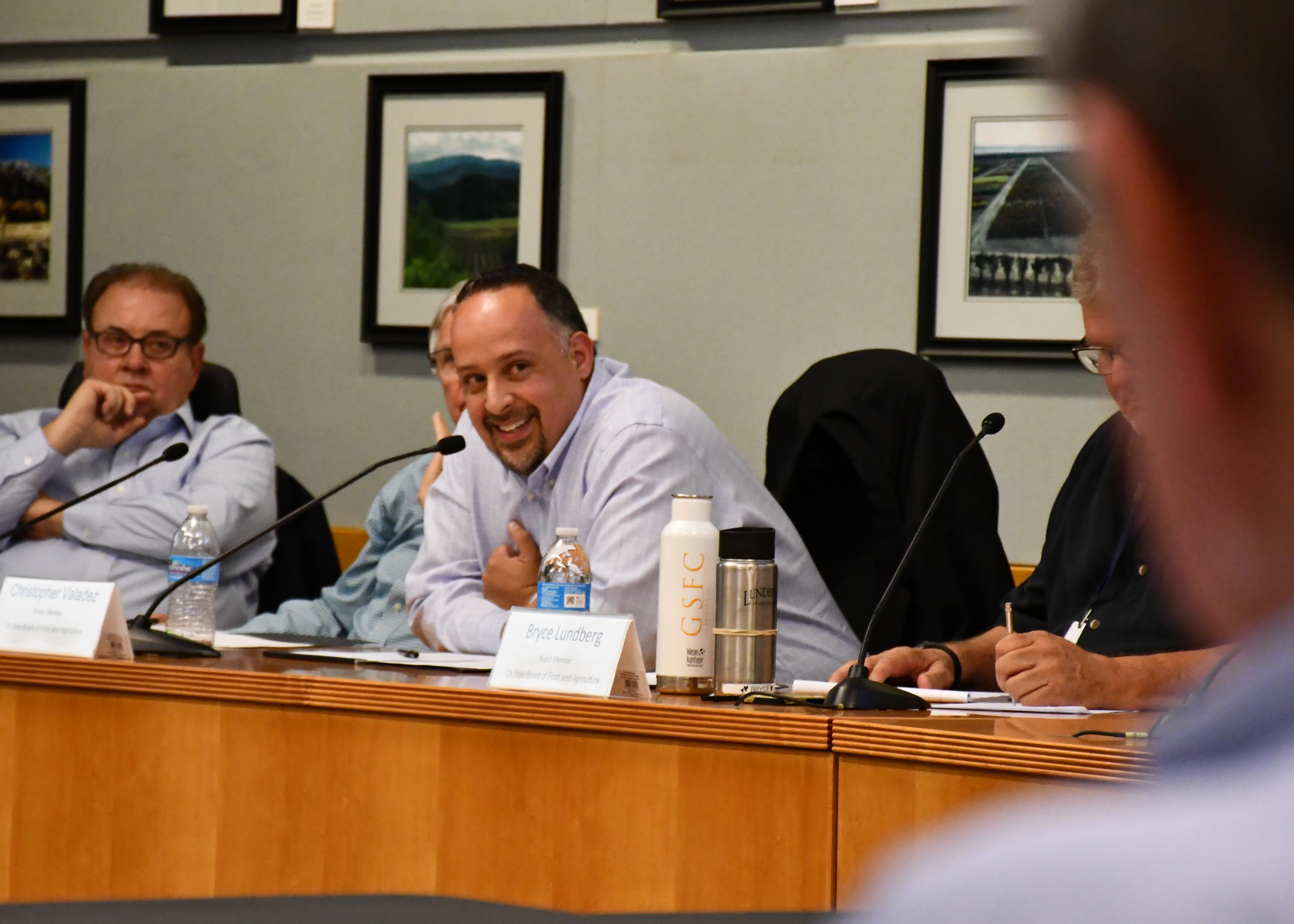Agricultural groups worry a new COVID-19 regulation passed last Thursday sets unrealistic mandates for protecting farmworkers in employer-provided housing and transportation.
During a full-day hearing, a number of business and trade groups testified that protocols established throughout the year—by businesses, counties and state agencies—were ignored in the workplace safety standard. The Division of Occupational Safety and Health of California (Cal/OSHA) board, acknowledging the emergency regulation still has many flaws to be addressed over the coming months, passed the measure unanimously.
“This is an emergency regulation that will apply incredibly broadly to almost every employer in the state,” said Rob Moutrie, a policy advocate for the California Chamber of Commerce, which led the business coalition opposing the measure.
The regulation’s narrow definition of an outbreak, he argued, would place many large employers in perpetual outbreak status, since social spread will reintroduce infections among employees, especially following Thanksgiving gatherings. Cal/OSHA defines an outbreak as three or more cases in a workplace within a two-week period.
The Western Growers Association and many others argued the standard was unnecessary and overly broad and that the process was rushed and lacked transparency. The 21-page final draft of the regulation along with a 57-page accompanying document were made public just five days before board approval. Claiming a lack of due process, the Western Agricultural Processors Association is considering legal action.
Much of the regulation codifies Cal/OSHA guidance already in place, such as requiring masks and social distancing, and adds new spacing standards of six feet apart for beds in employer-provided housing and three feet apart for workers being transported to job sites. Employers are also required to investigate cases in the workplace, provide free testing and continue pay and benefits while employees take leave for two weeks or more due to an exposure.
“It makes no sense to make employers responsible and the public safety net for COVID-19, which is exactly what this regulation does,” said Michael Miiller, director of government relations for the California Association of Winegrape Growers.
Miiller argued this, along with the rushed process, will lead to harmful unintended consequences that inhibit existing initiatives. He pointed to the governor’s Housing for the Harvest program as an example, saying the isolation housing offered would not comply with the regulation’s strict requirements for separate cooking facilities.

CalChamber policy advocate Robert Moutrie
“No employer would ever refer an employee to housing for the harvest under this regulation,” he said.
Among his many points, Miiller argued that the issues the regulation targets have already been addressed through existing guidelines.
“When considering a burdensome regulation like this, eight months after the declaration of a pandemic, that begs the question of what took so long. Why didn't the state act earlier?” he said. “We all know the answer: The state did indeed act.”
He pointed to several executive orders issued by Gov. Gavin Newsom, guidance documents from Cal/OSHA and the Public Health Department and “stringent” city and county guidelines.
Farmers are already struggling to understand and implement requirements for recent legislative mandates as well, according to Bryan Little, the employment policy director with the California Farm Bureau Federation. The Cal/OSHA board’s emergency ruling is effective Nov. 29.
“With this truncated process, there's nobody—not the employer stakeholders, not employee stakeholders, nor the agency—that's going to be charged with trying to enforce this,” he said. “We're going to spend the next several months trying to fix what's in the draft.”
The industry is in the midst of implementing new practices related to several bills signed into law by the governor in October. Assembly Bill 685 requires ag employers to notify all employees, along with state agencies and labor unions, of a COVID-19 infection within 48 hours of an outbreak. AB 1867 expands paid sick leave benefits for food sector workers. And SB 1159 places the burden on employers for proving that infections took place off the jobsite when an employee is infected and claims workers' compensation.
In a hearing last week for the Assembly Labor and Employment Committee, the nonpartisan Legislative Analyst’s Office reported that Cal/OSHA has issued more than $1 million in citations to frontline industries since the pandemic spread to California in March. Food processing accounted for nearly half that amount, followed by healthcare, grocery stores, prisons and then agriculture, at $38,000.
In making a case for the COVID-19 regulation, Cal/OSHA cited more than 7,000 new complaints about workplace safety it has received since February, leading to more than 500 inspections. It specifically targets clusters and outbreaks at food manufacturing facilities and agricultural operations, claiming an “overrepresentation of migrant temporary farmworkers testing positive” for the virus.
Several advocates for the California Rural Legal Assistance Foundation argued Cal/OSHA could be doing much more to protect the disproportionately impacted H-2A guestworkers, especially on the Central Coast. Labor groups, which have long called for increased state funding to support more Cal/OSHA inspectors, lauded California and the new regulation for the following the lead of Oregon and Washington's COVID-19 rules.
Ana Padilla, executive director of the UC Merced Community and Labor Center, said the regulation is greatly needed. Since March, 14 counties have seen a rise of more than 50% in immigrant Latino deaths, “several with large establishments in industries with long records of employer noncompliance, most notably in agriculture and meatpacking,” she said.
Farm groups on the Central Coast, on the other hand, were among the first to establish isolation housing and rapid testing programs specifically for farmworkers.
“In this region, we have not had the case clusters or the large number of cases associated directly with employer-provided housing,” said Chris Valadez, president of the Grower-Shipper Association of Central California. “The regulation recognizes but doesn't necessarily connect the fact that there's an infrastructure in place today.”
Valadez explained that part of that effort has been to include screens in employee housing and other “engineering controls” when six feet of separation is not possible. Board members acknowledged that even six feet when indoors for long periods does not eliminate risk. Other agricultural members called for the six feet to be measured between head spaces and not bunk-to-bunk.
Separating workers by three feet on transportation, meanwhile, would allow for just a driver and three workers for each ride in a 15-passenger van, according to Matt Rogers, the general manager for AgSocio, an agricultural employer in the Central Coast area.

Grower-Shipper Association of Central California President Chris Valadez
“The requirement may very well set back safe agricultural transportation in this state,” he said, calling it unaffordable and arguing it would push employees to pile into private cars with no safety measures.
Interested in more coverage and insights? Receive a free month of Agri-Pulse West.
The labor contractor had a number of safety standards in place for nine months. Rogers said these mitigation efforts prevented virus spread in two cases when infected workers rode in the company’s transportation service and lived in its housing. He feared AgSocio would not be able to meet the new requirements, setting him back for 2021 contracts already signed and leading to a loss of agricultural clients.
“I understand that there are going to be short-term costs and burdens as a result of this rule,” said Cal/OSHA Chief Doug Parker. “But the human and economic costs are extremely high of not acting and doing more to prevent the spread and transmission of COVID-19.”
He described the threat as “the most significant workplace hazard in the history” of the division, which requires an “aggressive” and “serious” rule. Parker asserted the requirements for pay and benefits are not out of Cal/OSHA’s jurisdiction and that the regulation is consistent with laws like AB 685 and existing local and state ordinances.
“In terms of implementation, we understand that this is not going to be any small task,” he said. “It does have some complexity.”
Parker added that Cal/OSHA will take into account the fact that some employers will need more time. He dismissed concerns about the social spread of the virus coming into the workplace, calling those distinctions irrelevant once the coronavirus is onsite. As far as inhibiting the Housing for the Harvest program, Parker said that is not the intention and the inspectors will have to make that decision on a case-by-case basis.
“Do you really think that this regulation, as it's being proposed, will bridge the gap for agriculture, retail, restaurants, schools and hotels,” said Chris Laszcz-Davis, the management representative on the Cal/OSHA board, “if it's not entirely clear in terms of nuanced interpretation and implementation?”
In terms of providing clarity to employers, responded Parker, “that's where our implementation strategy kicks in.”
Laszcz-Davis also pushed for forming an advisory committee to begin meeting immediately to start considering revisions to the regulation. Board Chair David Thomas agreed, adding Cal/OSHA should act quickly to “allay the fears of some of the employers,” but said the regulation itself should not be delayed any longer.
“We're seeing the worst of this right now,” he said. “We've got to lead at some point. Nobody else is doing it. We have no leadership from D.C.”
Thomas had not heard from the federal COVID-19 Task Force in months.
Upon approving the emergency regulation, the board passed it to the Office of Administrative Law for review, which adds another opportunity for public comment. The regulation is effective for 180 days, and the board can decide then whether to extend it or proceed with a formal rulemaking for a permanent standard.
For more news, go to: www.Agri-Pulse.com


